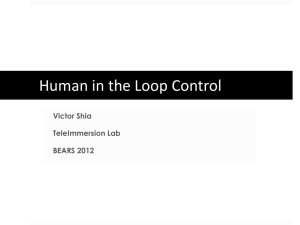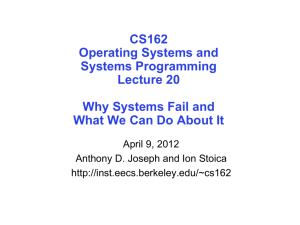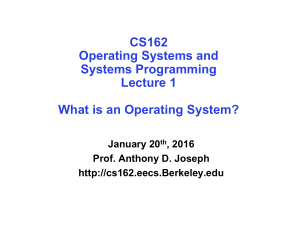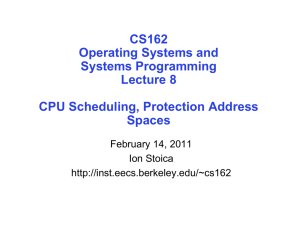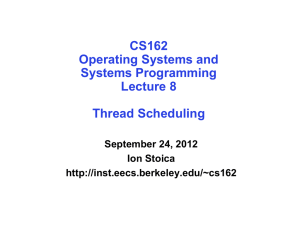Section-9x
advertisement
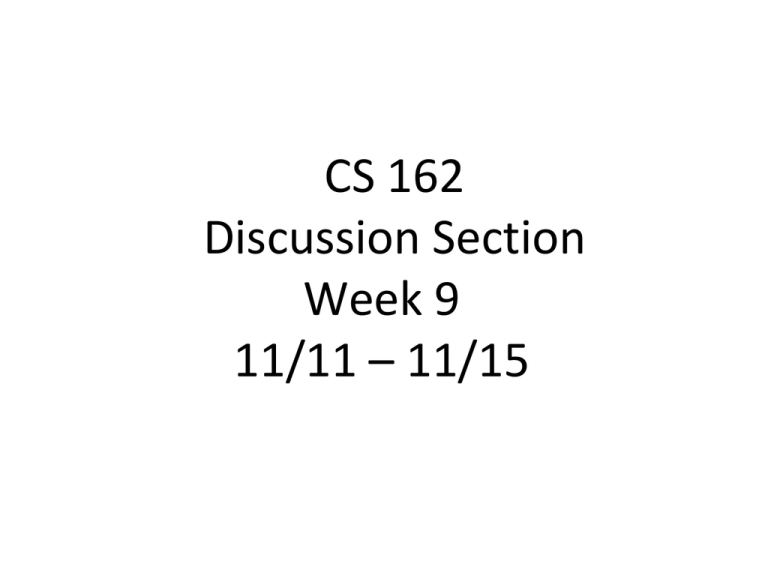
CS 162 Discussion Section Week 9 11/11 – 11/15 Today’s Section ● ● ● ● Project discussion (5 min) Quiz (10 min) Lecture Review (20 min) Worksheet and Discussion (20 min) Project 3 ● Due 11/12 (Today!) at 11:59 PM submit proj3-initial-design ● Due 11/21 (Next Thursday) at 11:59 PM submit proj3-code ● Questions? Quiz… Quiz 18.2: Databases • Short Answer: 1. What are the 4 properties of an ACID transaction (2 points)? • True/False: Choose 3 (stolen from lecture slides again) 2. A relational data model is the most used data model T 3. Transactions are not guaranteed to preserve the consistency of a storage system F 4. A DBMS uses a log to implement atomicity T 5. Durability isolates the reads and writes of a transaction from all other transactions F 11/6/13 Anthony D. Joseph and John Canny CS162 ©UCB Fall 2013 Lec 18.5 Quiz 18.2: Databases • Short Answer: 1. What are the 4 properties of an ACID transaction (2 points)? • True/False: 2. A relational data model is the most used data model 3. Transactions are not guaranteed to preserve the consistency of a storage system 4. A DBMS uses a log to implement atomicity 5. Durability isolates the reads and writes of a transaction from all other transactions 11/6/13 Anthony D. Joseph and John Canny CS162 ©UCB Fall 2013 Lec 18.6 Lecture Review What is a Database • A large organized collection of data • Models real world, e.g., enterprise – Entities (e.g., teams, games) – Relationships, e.g., Cal plays against Stanford in The Big Game 11/6/13 Anthony D. Joseph and John Canny CS162 ©UCB Fall 2013 Lec 18.8 Key Concept: Structured Data • A data model is a collection of entities and their relationships • A schema is an instance of a data model – E.g., describes the fields in the database; how the database is organized • A relational data model is the most used data model – Relation, a table with rows and columns – Every relation has a schema which describes the fields in the columns 11/6/13 Anthony D. Joseph and John Canny CS162 ©UCB Fall 2013 Lec 18.9 What is a Database System? • A Database Management System (DBMS) is a software system designed to store, manage, and facilitate access to databases. • A DBMS provides: – Data Definition Language (DDL) » Define relations, schema – Data Manipulation Language (DML) » Queries – to retrieve, analyze and modify data. – Guarantees about durability, concurrency, semantics, etc 11/6/13 Anthony D. Joseph and John Canny CS162 ©UCB Fall 2013 Lec 18.10 Key Concepts: Queries, Query Plans, and Operators Pick columns:(sid, name, gpa) SELECT sid, name, gpa FROM Students S WHERE S.gpa > 3 Projection Select Select all students with GPA>3 Students System handles query plan generation & optimization; ensures correct execution. Students Courses Enrolled Select all students with GPA > 3.0 11/6/13 Anthony D. Joseph and John Canny CS162 ©UCB Fall 2013 Lec 18.11 Key concept: Transaction • An atomic sequence of database actions (reads/writes) • Takes DB from one consistent state to another transaction consistent state 1 11/6/13 Anthony D. Joseph and John Canny consistent state 2 CS162 ©UCB Fall 2013 Lec 18.12 Concurrent Execution & Transactions • Concurrent execution essential for good performance – Disk slow, so need to keep the CPU busy by working on several user programs concurrently • DBMS only concerned about what data is read/written from/to the database – Not concerned about other operations performed by program on data • Transaction – DBMS’s abstract view of a user program, i.e., a sequence of reads and writes. • Locks are an important part of concurrency control. 11/6/13 Anthony D. Joseph and John Canny CS162 ©UCB Fall 2013 Lec 18.13 Locking Granularity • What granularity to lock? – Database – Tables – Rows Database Table 1 Table 3 Row Table 2 Table 4 • Fine granularity (e.g., row) high concurrency – Multiple users can update the database and same table simultaneously • Coarse granularity (e.g., database, table) simple, but low concurrency 11/6/13 Anthony D. Joseph and John Canny CS162 ©UCB Fall 2013 Lec 18.14 The ACID properties of Transactions • Atomicity: all actions in the transaction happen, or none happen • Consistency: transactions maintain data integrity, e.g., – Balance cannot be negative – Cannot reschedule meeting on February 30 • Isolation: execution of one transaction is isolated from that of all others; no problems from concurrency • Durability: if a transaction commits, its effects persist despite crashes 11/6/13 Anthony D. Joseph and John Canny CS162 ©UCB Fall 2013 Lec 18.15 Atomicity • A transaction – might commit after completing all its operations, or – it could abort (or be aborted) after executing some operations • Atomic Transactions: a user can think of a transaction as always either executing all its operations, or not executing any operations at all – Database/storage system logs all actions so that it can undo the actions of aborted transactions 11/6/13 Anthony D. Joseph and John Canny CS162 ©UCB Fall 2013 Lec 18.16 Consistency • Data follows integrity constraints (ICs) • If database/storage system is consistent before transaction, it will be after • System checks ICs and if they fail, the transaction rolls back (i.e., is aborted) – A database enforces some ICs, depending on the ICs declared when the data has been created – Beyond this, database does not understand the semantics of the data (e.g., it does not understand how the interest on a bank account is computed) 11/6/13 Anthony D. Joseph and John Canny CS162 ©UCB Fall 2013 Lec 18.17 Isolation • Each transaction executes as if it was running by itself – • It cannot see the partial results of another transaction Techniques: 11/6/13 – Pessimistic – don’t let problems arise in the first place – Optimistic – assume conflicts are rare, deal with them after they happen Anthony D. Joseph and John Canny CS162 ©UCB Fall 2013 Lec 18.18 Durability • Data should survive in the presence of – System crash – Disk crash need backups • 11/6/13 All committed updates and only those updates are reflected in the database – Some care must be taken to handle the case of a crash occurring during the recovery process! Anthony D. Joseph and John Canny CS162 ©UCB Fall 2013 Lec 18.19 This Lecture • Deal with (I)solation, by focusing on concurrency control • Next lecture focus on (A)tomicity, and partially on (D)urability 11/6/13 Anthony D. Joseph and John Canny CS162 ©UCB Fall 2013 Lec 18.20 Goals of Transaction Scheduling • Maximize system utilization, i.e., concurrency – Interleave operations from different transactions • Preserve transaction semantics – Semantically equivalent to a serial schedule, i.e., one transaction runs at a time T1: R, W, R, W T2: R, W, R, R, W Serial schedule (T1, then T2): Serial schedule (T2, then T1): R, W, R, W, R, W, R, R, W R, W, R, R, W, R, W, R, W 11/6/13 Anthony D. Joseph and John Canny CS162 ©UCB Fall 2013 Lec 18.21 Two Key Questions 1) Is a given schedule equivalent to a serial execution of transactions? Schedule: R, R, W, W, R, R, R, W, W º? º? Serial schedule (T1, then T2): :R, W, R, W, R, W, R, R, W Serial schedule (T2, then T1): R, W, R, R, W, R, W, R, W 2) How do you come up with a schedule equivalent to a serial schedule? 11/6/13 Anthony D. Joseph and John Canny CS162 ©UCB Fall 2013 Lec 18.22 Transaction Scheduling • Serial schedule: A schedule that does not interleave the operations of different transactions – Transactions run serially (one at a time) • Equivalent schedules: For any storage/database state, the effect (on storage/database) and output of executing the first schedule is identical to the effect of executing the second schedule • Serializable schedule: A schedule that is equivalent to some serial execution of the transactions – Intuitively: with a serializable schedule you only see things that could happen in situations where you were running transactions one-at-a-time 11/6/13 Anthony D. Joseph and John Canny CS162 ©UCB Fall 2013 Lec 18.23 Conflict Serializable Schedules • Two operations conflict if they – Belong to different transactions – Are on the same data – At least one of them is a write • Two schedules are conflict equivalent iff: – Involve same operations of same transactions – Every pair of conflicting operations is ordered the same way • Schedule S is conflict serializable if S is conflict equivalent to some serial schedule 11/6/13 Anthony D. Joseph and John Canny CS162 ©UCB Fall 2013 Lec 18.24 Conflict Equivalence – Intuition • If you can transform an interleaved schedule by swapping consecutive non-conflicting operations of different transactions into a serial schedule, then the original schedule is conflict serializable • Example: T1:R(A),W(A), R(B),W(B) T2: R(A),W(A), R(B),W(B) T1:R(A),W(A), R(B), W(B) T2: R(A), W(A), R(B),W(B) T1:R(A),W(A),R(B), W(B) T2: R(A),W(A), R(B),W(B) 11/6/13 Anthony D. Joseph and John Canny CS162 ©UCB Fall 2013 Lec 18.25 Conflict Equivalence – Intuition • If you can transform an interleaved schedule by swapping consecutive non-conflicting operations of different transactions into a serial schedule, then the original schedule is conflict serializable • Example: T1:R(A),W(A),R(B), W(B) T2: R(A),W(A), R(B),W(B) T1:R(A),W(A),R(B), W(B) T2: R(A), W(A),R(B),W(B) T1:R(A),W(A),R(B),W(B) T2: R(A),W(A),R(B),W(B) 11/6/13 Anthony D. Joseph and John Canny CS162 ©UCB Fall 2013 Lec 18.26 Dependency Graph • Dependency graph: – Transactions represented as nodes – Edge from Ti to Tj: » an operation of Ti conflicts with an operation of Tj » Ti appears earlier than Tj in the schedule • Theorem: Schedule is conflict serializable if and only if its dependency graph is acyclic 11/6/13 Anthony D. Joseph and John Canny CS162 ©UCB Fall 2013 Lec 18.27 Example • Conflict serializable schedule: T1:R(A),W(A), R(B),W(B) T2: R(A),W(A), R(B),W(B) A B T1 T2 Dependency graph • No cycle! 11/6/13 Anthony D. Joseph and John Canny CS162 ©UCB Fall 2013 Lec 18.28 Example • Conflict that is not serializable: T1:R(A),W(A), R(B),W(B) T2: R(A),W(A),R(B),W(B) A T1 T2 Dependency graph B • Cycle: The output of T1 depends on T2, and viceversa 11/6/13 Anthony D. Joseph and John Canny CS162 ©UCB Fall 2013 Lec 18.29 Serializability ≠ Conflict Serializability • Following schedule is not conflict serializable Dependency graph A T1:R(A), W(A), A T1 T2 T2: W(A), A A T3: WA T3 • However, the schedule is serializable since its output is equivalent with the following serial schedule T1:R(A),W(A), T2: W(A), T3: WA • Note: deciding whether a schedule is serializable (not conflict-serializable) is NP-complete 11/6/13 Anthony D. Joseph and John Canny CS162 ©UCB Fall 2013 Lec 18.30 Summary • Transaction: a sequence of storage operations • ACID: – Atomicity: all operations in a transaction happen, or none happens – Consistency: if database/storage starts consistent, it ends up consistent – Isolation: execution of one transaction is isolated from another – Durability: the results of a transaction persists • Serial schedule: A schedule that does not interleave the operations of different transactions – Transactions run serially (one at a time) 11/6/13 Anthony D. Joseph and John Canny CS162 ©UCB Fall 2013 Lec 18.31 Worksheet…

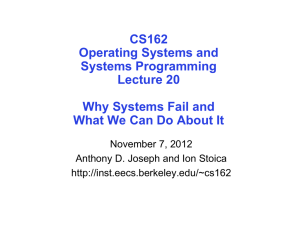
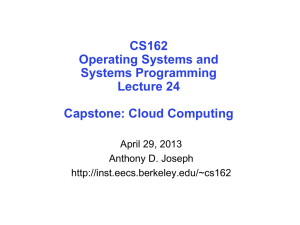
![Title of the Presentation Line 1 [36pt Calibri bold blue] Title of the](http://s2.studylib.net/store/data/005409852_1-2c69abc1cad256ea71f53622460b4508-300x300.png)
